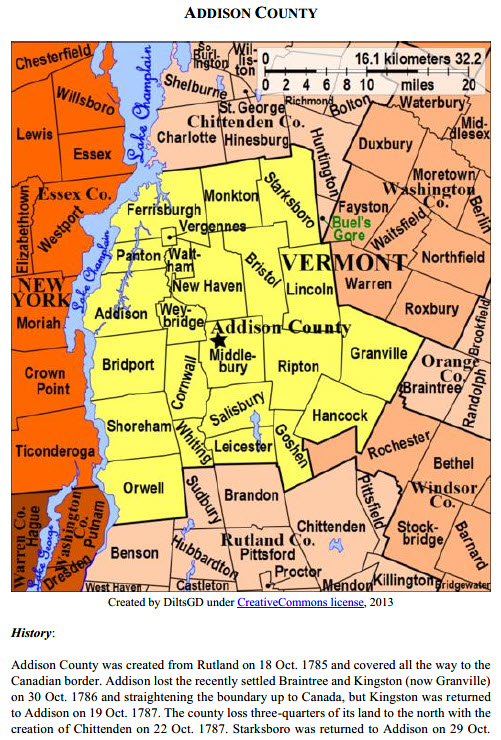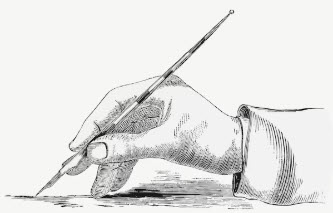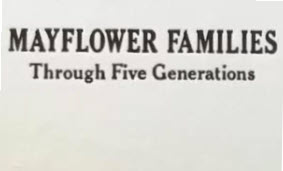Introduction
The Vermont Research Guide is a new, comprehensive, and up-to-date guide designed to assist genealogists and historians in identifying the available state and county-level records for Vermont. It provides color images of maps and records.

Published in 2025, this 186-page spiral-bound guide is divided into four sections:
- It begins with a brief history of all periods up to Vermont’s statehood in 1791 and an associated bibliography for each period.
- It then covers all the major record groups genealogists might use, including the history of those records and what they can find within them. Each record group is again followed by its own bibliography.
- The third section discusses existing and past counties, the records covering each, border changes, and the location of those records.
- The final section provides a town grid with names (and former names), dates for grants, settlement, and organization, as well as the respective county, the towns’ probate districts, and likely locations for vital and church records.
Throughout the guide, information is provided on published material along with live links to internet resources. Tables, images, and county maps provide additional information.
Value To Researchers
Most experienced genealogists start their efforts by defining narrow research questions about individuals which include specific times and places. Their research plans then seek to identify all the pertinent sources and where to find them – essentially a “locality guide.” Developing that often depends either on years of experience researching in that area or many hours of study and searching.
The Vermont Research Guide identifies all the most relevant state and county sources, repositories and their addresses. For research projects involving Vermont ancestry, it is hard to imagine a more important resource sitting nearby. It can literally saves hours identifying the most relevant sources and where to find them.
If you plan to perform genealogical research in Vermont, we believe you will quickly find this guide to be an indispensable tool.
A. Contents
This is simply a list with starting page number for the 27 sections of the guide.

B. History
This part covers major periods in Vermont’s history up to statehood in 1792, and includes:
Native American Period
French Period (1609-1759)
Massachusetts Period (to 1740)
New Hampshire Period (1741-1764)
New York Period (1764-1777)
Vermont (as an independent republic, 1777-1791)
C. Records
This section covers all major record types including:
| Vital Records | Cemetery Records | Law | Town History |
| Land Records | Census Records | Migration | Periodicals |
| Court Records | Church Records | Ethnicity | Newspapers |
| Probate Records | Military Records | Eugenics | Almanac/Directory |
| Adoption Records | Government | Geography |
Example: Vital Records
Background & Context
Unlike the rest of the country, New England states in varying degrees have maintained a record keeping system since their first settlement, with the town as the primary record creator. Vermont is one of the purest forms of that concept. It is the town record that is the original source. Genealogists need to keep this in mind when they encounter a problem with data. The statewide index is the most readily accessed source, but it is not the original.
The first Vermont law requiring vital records registration was early, in 1779, as described in the duties of the town clerk. [10] However, this did not seem to compel people to register vital events. In these early years to about 1820, births and deaths were recorded in family groups and occasionally included the marriage of the parents as well. These records were often recorded after all the children were born. [continued…]
Records Requirements
Vital record registration as we think of it today started for Vermont in 1857. Each town clerk was required to transcribe, in June on an annual basis, all births, marriages, and deaths occurring during the year preceding the first day of January. The town clerks were aided by [continued…]
Links to Resources
The state index is the likely reason why only a few Vermont town vital records have been published in journals or standalone publications. The following were published in Vermont Genealogy, the journal of the Genealogical Society of Vermont:
- Scott Andrew Bartley, “Vital Records from the Hartford District [northern Windsor County] Probate Records, v. 18-25,” 15 [2010]: 58-79 [americanancestors.org/ DB2772/i/58589/58] ($).
- Scott Andrew Bartley, “Vital Records of Springfield, Vt.” [Special Publication Number 13] in 16, No. 1 [Spring 2011] – with index [americanancestors.org/ DB2772/i/58590/1] ($).
- Eric G. Grundset, “Brookline, Vermont, Vital Records Prior to 1857,” 9 [2004]: 122-133, 179-192 [americanancestors.org/DB2772/i/58601/122] ($).
Example: Cemetery Records
Background and Context
The United States has seen many types of cemeteries. The first were the frontier graves that were often a single burial. Private family plots developed in the rural areas. Churchyards were established as congregations formed and built their meetinghouses. Towns eventually supported their own non-denominational cemeteries. The town also provided a place for the poor. The burial business moved into the private sector with bigger, more elaborate landscaping. The government established military cemeteries during the Civil War. Cemeteries, until recently, have always been segregated by race.
Frontier graves were made by the first adventurers in an area, whether it is the 1600s or the 1800s. These gravesites were generally isolated with no more than a couple burials each, and often just a single burial. Many early settlers considered a place near an already established Indian burial ground as a more favorable location. The site had no markings to identify the deceased, let alone the plot.
Private family plots still dot the landscape. These small cemeteries were the first permanent cemeteries created in most areas. They consisted of [continued…]
Resources

[continued…]
D. Repositories
Those covered in this guide include:
- Colleges and Universities
- State Repositories
- Research Libraries
- State Genealogical Societies
E. Counties
This section includes a discussion and references for the early jurisdictions defined by Massachusetts, New Hampshire, and New York. It then goes into the details for each Vermont county including its history, color maps delineating town boundaries, lists of existing and former town names, courts, probate districts, deeds, and newspapers with year of coverage, and whether available digitally. Some examples of the type of information in this section are described below.
History
Franklin County was created from Chittenden County on 5 Nov. 1792, but administratively attached until 1 Dec. 1796. The county then included the northern half of the current Grand Isle County and the northwest half of the current Lamoille County. Orleans County was attached to Franklin from 1 Dec. 1796 to 30 Nov. 1799. The county lost the islands to the creation of Grand Isle County on 9 Nov. 1802, though it was administratively attached until 30 Nov. 1805. Franklin lost its southeast corner on the creation of Lamoille County on 26 Oct. 1835, though that part remained attached until 30 Nov. 1836. The border has remained unchanged since 1 Mar. 1897.
The current towns in Franklin County are:
| Bakersfield | Berkshire | Enosburg | Fairfield |
| Fletcher | Fairfax | Fairfield | Georgia |
| Highgate | Montgomery | Richford | Sheldon |
| St. Albans | Swanton |
The former towns of Franklin County:
Alburg, Isle la Motte, and North Hero lost to the creation of Grand Isle County on 9 Nov.1802, but not administratively separated until 1 Dec. 1805. Belvidere, Cambridge, Johnson, and Waterville lost to the creation of Lamoille County on 26 Oct. 1835, but not administratively separated until 1 Dec. 1836.
County Maps
A map of town boundaries is provided for each county. The boundaries to adjacent counties, states, or countries are included along with the nearest towns in those jurisdictions.
Court Records at the State Archives:
- Supreme Court cases heard in Franklin County, 1820-1952 (SUPR-FR-003), 26cf.
- Franklin County Court record books, 1798-1919 (FRCC-002), 34v.
- Franklin County Court dockets, 1818-1912, 1919, 1944-1968 (FRCC-001), 27cf.
- Franklin County Court case files, 1831-1956 (FRCC-003), 80cf.
Probate Records:
Franklin Probate Division
17 Church Street
St. Albans VT 05478
(802) 524-4112
Hours: M-F 8-4:30
Lists of local and online probate sources:
Card index, 1780-1970 [familysearch.org/search/catalog/1192775].
Record books, 1796-c1953 [familysearch.org/search/catalog/2018028].
[continued…]
Newspapers to 1850:
This is listing of newspapers published in the county. All of these have been microfilmed. The first column identifies if the paper is digitized. C is ChroniclingAmerica.gov; G is GenealogyBank.com ($); and N is Newspapers.com ($). The next column is the years published in chronological order, place of publication, and then the name (that can vary). Realize that if more than one site has a title, each site may have different issues available.
| Digital | Years | Place | Name |
| G | 1808-1809 | St. Albans | St. Albans Adviser |
| G, N | 1809-1810 | St. Albans | Champlain Reporter |
| 1810-1811 | St. Albans | Franklin County Advertiser |
These lists may include a dozen or more newspapers of interest.
F. Town Data
The Town is the current name used. Names in bold have W.P.A. Inventories published for the town. Those in italics were earlier names no longer used or a town no longer existing. Cross references are given. Note that if a place is unincorporated, a grant, or gore, any records that might have been created here will be with the county clerk. It is managed by a supervisor appointed by the state. For more information about towns or place names, see [continued…]
Excerpt from the table of town data which includes 10 cities, 237 towns, 40 incorporated villages (subset of a town), 3 townships (towns never organized), 2 unorganized towns (i.e., former organized towns), 3 gores, and 1 grant (essentially a gore).
G. New York Patents
New York issued 107 patents for land the size of towns – many with names that conflict with already granted towns by New Hampshire. More were issues to retired military men and those are not included here as they had no effect on Vermont settlement. There were 83 town-named patents. Five of these were the founding of the Vermont towns (listed here and in the previous list as well) and twenty were “confirming” patents to places already granted by New Hampshire confirming title to the land (also in both lists). The remaining 58 patents were “paper towns” that did not result in settlement. The data came from Esther Munroe Swift, Vermont Place-Names (Brattleboro, Vt., 1977).
Excerpt from table of New York patents involving Vermont.
Summary
This post is a snapshot of the kind of information included in this guide – identifying some of the types of genealogical and historical sources that it includes. It only touches on a few; the guide’s scope is exhaustive.
We hope that it demonstrates the breadth and detail that Drew Bartley has provided in this publication and how it might help you with future research in the state.
If you have any additional questions about the guide or how to obtain a copy, check the link on our homepage (www.vtgenlib.org), write to us at mail@vtgenlib.org or call us at 802-871-5647.










